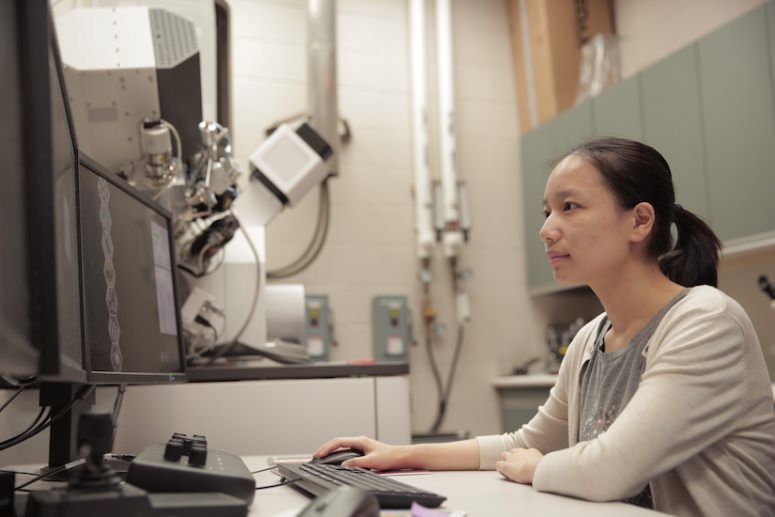Oct 6 2017
With $15.6 million support from the National Science Foundation (NSF), the University of Wisconsin–Madison center for research on materials like glass, semiconductors and liquid crystals will continue to pursue its work.
 Chemical engineering Ph.D. student Yingxin Guan conducts research with a plasma focused ion beam microscope. Photo: Renee Meiller/Uw-Madison College Of Engineering
Chemical engineering Ph.D. student Yingxin Guan conducts research with a plasma focused ion beam microscope. Photo: Renee Meiller/Uw-Madison College Of Engineering
The grant ensures six years of funding for the Materials Research Science and Engineering Center, based in UW–Madison’s College of Engineering and including 30 affiliated faculty from nine departments throughout the university.
Researchers at MRSEC, which was founded in 1996, explore crucial, large-scale and complex questions in materials science.
These questions require large groups comprised of researchers with skills in synthesis and characterization of materials, materials processing and in theory and computation. Only with these interdisciplinary groups can we go after problems that are really difficult and that involve fundamental questions in materials-related areas. If we can address them, they will lead to breakthroughs that will transform our understanding of materials and lead to a new slate of technologies. It’s high-risk, high-reward research.
Nick Abbott, Director of MRSEC and Professor of Chemical and Biological Engineering
It is the high-risk nature of the research that makes NSF’s extensive and flexible funding commitment so vital, Abbott says. MRSEC-affiliated faculty have the freedom to exhaustively track fundamental issues — a painstaking process that can frequently conclude without the famous “eureka!” moment of discovery.
But NSF’s long-term commitment has also produced groundbreaking research: semiconductor synthesis from new materials, with wide implications for electronics; the employment of liquid crystals for sensing, with applications in wearable technologies that detect airborne lethal gases and the highly efficient energy transfer capacity of carbon nanotubes. The property makes them a potential candidate for next-generation solar energy harvesting.
Another could come in the form of better understanding of glasses, a significant thrust of MRSEC research. Most people understand glass as a brittle, transparent material beneficial for making storage containers, windowpanes and smartphone screens. But there are metal and plastic glasses, and MRSEC Researchers may come up with totally new categories of glasses, according to Chemistry Professor Mark Ediger, Co-investigator with Paul Voyles, Professor of Materials Science and Engineering.
Our project seeks a fundamental understanding of glassy materials that enables the development of new glasses that might extend the life of machine tools or enable advances in quantum computing or lead to even better cell phone displays.
Mark Ediger, Chemistry Professor and Co-investigator, The University of Wisconsin-Madison
The Researchers guided by Chemical and Biological Engineering Professor Tom Kuech and Materials Science and Engineering Professor Paul Evans hope to accelerate progress in quantum information technologies, including quantum computing, by producing thin films from complex oxides.
The films typically have uncommon crystal structures displaying amazing magnetic, electronic and optical properties. Comprehending them will only happen through continuous investment in major research, the type of investment that NSF’s MRSEC funding provides.
“NSF support really goes a long way at UW–Madison and has a significant and broad impact,” Evans says. “And that impact is underpinned by the basic science happening at MRSEC. The basic scientific research provides the foundation for highly valuable education and outreach activities.”
MRSEC also supports globally recognized educational and outreach programs, creating and distributing research-inspired educational kits and activities to Teachers who integrate basic materials science concepts in numerous high school classrooms.
Abbott says the new funding will be useful for MRSEC to transition from physical kits to creating digital educational materials in the form of educational games, which could reach more number of schoolchildren.
“The UW–Madison MRSEC has been a national leader in education for decades, with measurable impact worldwide,” says Engineering Physics Professor Wendy Crone, who Co-leads MRSEC educational and outreach programs with Anne Lynn Gillian-Daniel, Director of the Interdisciplinary Education Group. Crone added, “We have created science kits, teaching laboratories, web-based content for K-12 teachers, museum exhibits, outreach activities and now digital games.”
According to Abbott, MRSEC’s impact includes millions of dollars of scientific equipment that is available for use by industry and Researchers both on and off the UW–Madison campus. Furthermore, the Advanced Materials Industrial Consortium - a group of companies - along with MRSEC faculty and staff provides priceless professional development opportunities for UW–Madison Students and Researchers.